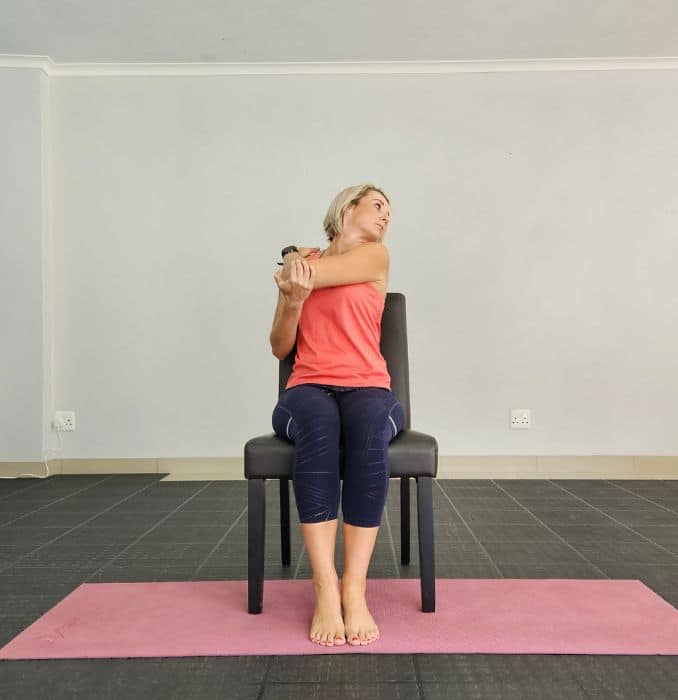
Neck pain ranks as the fourth most common reason for disability in the United States. Neck exercises for pain can be beneficial in managing and reducing symptoms.
As of 2019, about 27 people of various ages experience neck pain out of every 1,000 [¹].
In 2020, about 203 million people worldwide had neck pain [²].
It’s alarming, right?
But here are some exercises that you can do at home to relieve your neck pain.
Disclaimer:
Before starting any new exercise routine, it is recommended to consult with a healthcare professional. This is especially important if you have any pre-existing health conditions or concerns. The information provided here is for educational purposes only and should not be considered as medical advice or a substitute for professional guidance. Exercise should be performed according to your own capabilities and limitations.
3 Best Neck Exercises At Home
Here are three effective stretching exercises that you can do at home to alleviate discomfort:
1. Hands Behind Head Stretch
For this exercise, you can utilize a chair for support.
Begin in an upright sitting position on a chair with your feet flat on the floor, while maintaining good alignment of your head, shoulders, and hips. Lean your back against the backrest of the chair and place your hands behind your head, interlacing your fingers at the base of your head. Engage your core and gently press your head, creating tension between your hands.
Hold this position for approximately 30 seconds with 5 to 7 deep belly breaths, in through your nose and out through your mouth. Lastly, slowly lower your arms back to return to the starting position and repeat the movement as needed.

- Variation 1: Hands Behind Head Stretch
For this exercise, you can utilize a chair for support.
Firstly, begin in an upright sitting position on a chair with your feet flat on the floor, while maintaining good alignment of your head, shoulders, and hips. Then, lean your back against the backrest of the chair and place your hands behind your head, interlacing your fingers at the base of your head. Afterwards, cross your right leg over your left leg.
Moreover, engage your core and gently press your head, creating tension between your hands. There, shrug your shoulder blades up and down while holding the position for a few seconds with several deep belly breaths. After several repetitions, return to the starting position and repeat the movement as needed.
 |  |
- Variation 2: Hands Behind Head Stretch
For this exercise, you can utilize a chair for support.
Begin in an upright sitting position with your feet flat on the floor, while maintaining good alignment of your head, shoulders, and hips. Moreover, lean your back against the backrest of the chair. Afterwards, place your hands behind your head and interlace your fingers at the base of your head, keeping your head forward.
After that, engage your core and gently press your head, creating tension between your hands. Rotate your upper body to one side, and hold the position of 5 deep belly breaths; in through your nose and out through your mouth. Lastly, return to the starting position and repeat the movement on the other side.

2. Seated Neck Towel Stretch
For this exercise, you can utilize a chair for support and a towel for added resistance.
Firstly, begin in an upright sitting position on a chair with your feet flat on the floor, while maintaining good alignment of your head, shoulders, and hips. Moreover, relax your back against the backrest of the chair and place the towel at the back of your neck, holding the ends of the towel on each hand to support your cervical spine.
After that, engage your core and pull the ends of the towel towards your eyes, moving your head upward. Then, hold this position for 5 to 10 deep belly breaths, in through your nose and out through your mouth. Lastly, slowly return to the neutral position and repeat the movement as needed.

3. Seated Neck Rotation With Towel
For this exercise, you can utilize a chair for support and a towel for added resistance.
Begin in an upright sitting position on a chair with your feet flat on the floor, while maintaining good alignment of your head, shoulders, and hips. Afterwards, place the towel at the back of your neck, holding the ends of the towel in each hand at chest level. Then, engage your core and lift your right hand with the towel at neck level.
Then, slowly straighten your right arm up towards your left side as you tilt your head to the same direction. Therefore, hold this position with 5 deep belly breaths. Lastly, relax to return to the starting position and repeat the movement on the other side.
 |  |
For an added challenge, you can shrug your shoulders while holding the movement. Complete 2 to 4 repetitions on each side.
4. Modification
Do not worry if you do not have towels with you, we got you covered.
Firstly, begin in an upright sitting position on a chair with your feet flat on the floor, while maintaining good alignment of your head, shoulders, hips, and legs. Then, relax your back against the chair’s backrest and place your right hand on your left shoulder, then place your left hand on your right elbow.
Afterwards, engage your core and slowly turn and tilt your head towards your right side as you pull your right elbow towards the left side Hold this position with 5 deep belly breaths. Lastly, relax and change the position of your hands and repeat the movement in the opposite direction.
 |  |
For an added challenge, you can shrug your shoulders while holding the movement. Complete 2 to 4 repetitions on each side.
Why Is Exercise Important For Neck Pain Relief?

Exercise is crucial for neck pain relief for several reasons, addressing both the underlying causes and providing therapeutic benefits.
Here’s why exercise is important in alleviating neck pain:
- Strengthening Muscles
Regular neck stretches help strengthen the muscles that support the neck and spine. Stronger muscles provide better support, reducing strain on the neck and improving overall stability.
- Improving Posture
Many cases of neck pain are linked to poor posture, especially with the prevalence of desk jobs and increased screen time. Exercise can help correct and maintain proper posture, preventing unnecessary stress on the neck muscles and spine.
- Increasing Flexibility
Exercises for the neck, such as neck pain exercises at home, promote flexibility in the joints and muscles of the neck. Improved flexibility reduces stiffness and enhances the range of motion, allowing for smoother and pain-free movements.
- Enhancing Circulation
Physical activity increases blood circulation, delivering essential nutrients and oxygen to the neck’s muscles and tissues. Improved blood flow supports the healing process and helps reduce inflammation.
- Reducing Tension and Stress
Neck strengthening exercises often include relaxation techniques that help reduce muscle tension and stress. Stress and tension are common contributors to neck pain, and exercises that promote relaxation can provide significant relief.
- Preventing Future Pain
Regular exercise, including neck pain exercises at home, is an effective way to prevent recurring neck pain. Strengthening and conditioning the neck muscles make them more resilient to daily activities and less prone to strain.
- Addressing Underlying Issues
Certain exercises can target specific underlying issues that contribute to neck pain, such as muscle imbalances, poor joint mobility, or weak supporting muscles. Targeted exercises prescribed by healthcare professionals, like physical therapists, can address these issues directly.
To achieve relief from neck problems, approach any exercise routine with precaution.
Conclusion
Addressing neck pain involves a multifaceted approach, and incorporating exercises can be instrumental in relieving discomfort by enhancing neck mobility, reducing muscle tension, and improving overall strength. These exercises, when performed with proper form and consistency, contribute to a holistic strategy for managing and preventing neck pain.
It’s crucial to consult with a healthcare professional before initiating any exercise routine, especially for individuals with pre-existing conditions, and to pay attention to individual responses, adjusting the exercises as needed. Complemented by good posture habits and an awareness of underlying factors, these exercises offer a proactive and accessible means to promote long-term neck health.
Are you tired of living with neck pain? Say goodbye to discomfort and hello to relief with Neck Pain Solved! Our expert team is dedicated to providing you with the best solutions to alleviate your neck pain and improve your quality of life.

